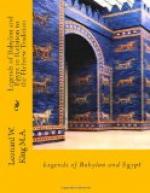(1) Cf. Zimmern,
Beitraege zur Kenntniss der Bab. Relig.,
pp. 116 ff.
The last of the five Antediluvian cities in our list is Shuruppak, in which dwelt Ut-napishtim, the hero of the Babylonian version of the Deluge. Its site has been identified with the mounds of Fara, in the neighbourhood of the Shatt el-Kar, the former bed of the Euphrates; and the excavations that were conducted there in 1902 have been most productive of remains dating from the prehistoric period of Sumerian culture.(1) Since our text is concerned mainly with the Deluge, it is natural to assume that the foundation of the city from which the Deluge-hero came would be recorded last, in order to lead up to the central episode of the text. The city of Ziusudu, the hero of the Sumerian story, is unfortunately not given in the Third Column, but, in view of Shuruppak’s place in the list of Antediluvian cities, it is not improbable that on this point the Sumerian and Babylonian Versions agreed. In the Gilgamesh Epic Shuruppak is the only Antediluvian city referred to, while in the Hebrew accounts no city at all is mentioned in connexion with Noah. The city of Xisuthros, too, is not recorded, but as his father came from Larankha or Larak, we may regard that city as his in the Greek Version. Besides Larankha, the only Antediluvian cities according to Berossus were Babylon and Sippar, and the influence of Babylonian theology, of which we here have evidence, would be sufficient to account for a disturbance of the original traditions. At the same time it is not excluded that Larak was also the scene of the Deluge in our text, though, as we have noted, the position of Shuruppak at the close of the Sumerian list points to it as the more probable of the two. It may be added that we cannot yet read the name of the deity to whom Shuruppak was allotted, but as it is expressed by the city’s name preceded by the divine determinative, the rendering “the God of Shuruppak” will meanwhile serve.
(1) See Hist. of Sum. and Akk., pp. 24 ff.




